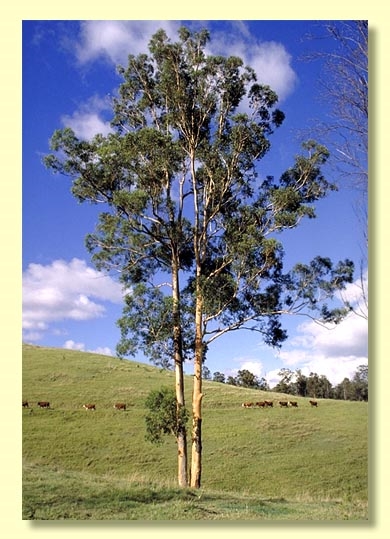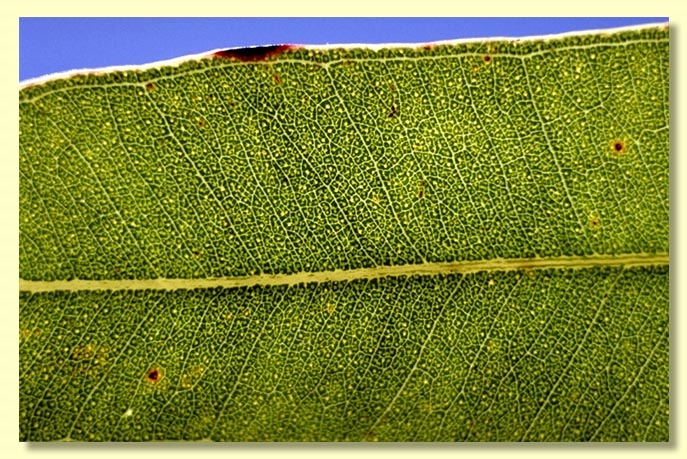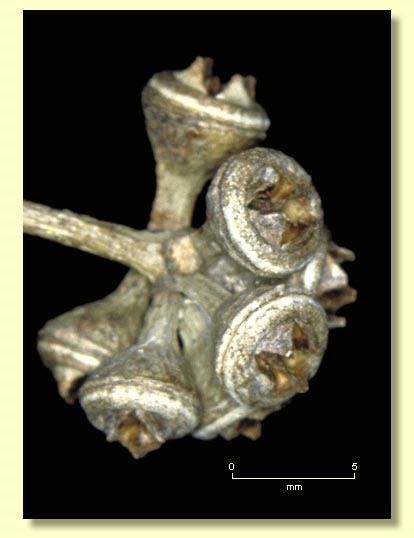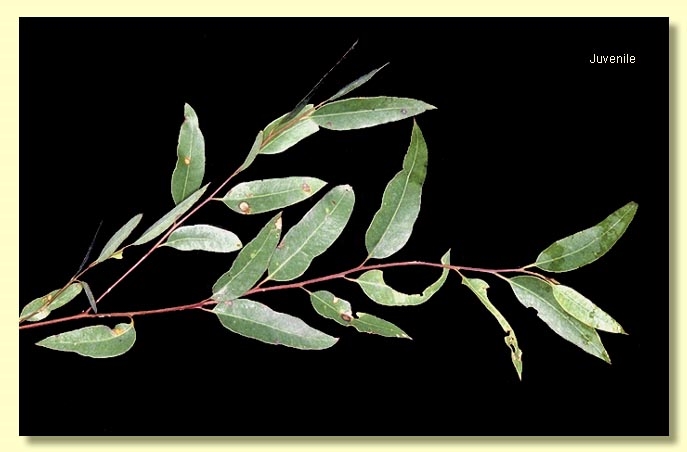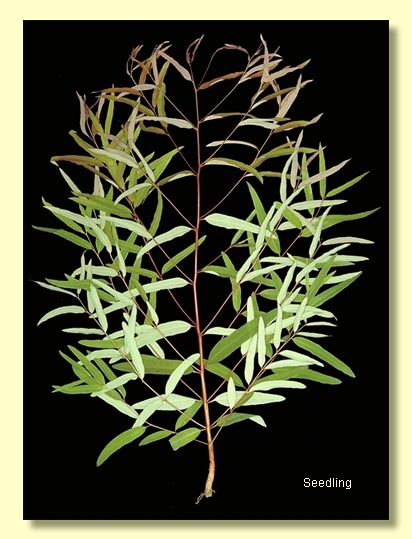Euclid - Online edition
Eucalyptus propinqua
Eucalyptus | Symphyomyrtus | Latoangulatae | Lepidotae-Fimbriatae
Eucalyptus propinqua H.Deane & Maiden, Proc. Linn. Soc. New South Wales 10: 541 (1896).
T: New South Wales. Stroud Rd, A.Rudder s.n., 10 February 1893; lecto NSW [NSW 308067]; fide Bean, A.R., Telopea 12(3): 317-318 (2009).
Bark smooth, becoming granular with age, mottled grey, cream, pink, orange, coppery or yellow, shedding in strips.
Juvenile growth (coppice or field seedlings to 50 cm): stem square in cross-section; juvenile leaves always petiolate, opposite for 4 to 6 nodes then alternate, lanceolate, 4–7.5 cm long, 1–2.2 cm wide, discolorous, base rounded or tapering to petiole, green.
Adult leaves alternate, petiole 1–2.2 cm long; blade lanceolate to falcate, 6–17 cm long, 1.5–2.5 cm wide, base tapering to petiole, discolorous, glossy or dull, darker green above, paler below, strongly penniveined, densely to very densely reticulate, intramarginal vein parallel to and just within margin, oil glands island and intersectional.
Inflorescence usually axillary unbranched but sometimes terminal compound, peduncles 0.5–1.5 cm long, angular to flattened, buds 7 to 15, pedicellate (pedicels 0.1–0.5 cm long). Mature buds clavate to ovoid (0.3–0.5 cm long, 0.3 cm wide), often with slight longitudinal ribs on hypanthium, scar present, operculum conical to rounded or slightly beaked, stamens inflexed, anthers cuboid or cuneate, versatile, dorsifixed, dehiscing by longitudinal slits (non-confluent), style long, stigma blunt, locules 3 or 4, the placentae each with 4 vertical ovule rows. Flowers white.
Fruit sessile or pedicellate (pedicels 0–0.6 cm long), obconical or hemispherical, 0.2–0.4 cm long, 0.4–0.6 cm wide, sometimes faintly ribbed longitudinally, disc raised-convex to annular or level, valves 3 or 4, strongly exserted.
Seeds brown, 1–1.5 mm long, pyramidal or cuboid, somewhat angular, dorsal surface smooth or shallowly pitted, hilum usually ventral or rarely terminal.
Cultivated seedlings (measured at ca node 10): cotyledons oblong; stems square in cross-section; leaves always petiolate, opposite for ca 5 nodes then alternate, lanceolate, 6–9 cm long, 1.5–2.5 cm wide, base tapering, discolorous, margin entire, apex pointed, darker green above, paler beneath.
Flowering has been recorded in January, February and April.
It has been used in heavy engineering, poles and as railway sleepers. Apiarist use it for the production of honey.
A medium-sized to tall forest tree, one of two small-fruited grey gums of coastal eastern Australia (the other is E. major). E. propinqua occurs from north of the Hawkesbury River in New South Wales to north of Gympie and west to the Blackbutt Range in south-eastern Queensland; also occurring on the eastern edge of the Northern Tableland of New South Wales near Long Point south-east of Armidale. E. propinqua is characterised by its dull granular smooth mature bark, its strongly discolorous adult leaves which are paler on the underside and have dense to very dense reticulation and numerous secondary veins at a wide angle to the mid rib and its small buds and fruit.
Eucalyptus propinqua belongs in Eucalyptus subgenus Symphyomyrtus section Latoangulatae because cotyledons are bilobed, leaves are discolorous and have side-veins at a wide angle to the midrib, buds have two opercula and fruit have exserted valves. Within this section, it is one of six species forming series Lepidotae-Fimbriatae (the Grey gums) with ovules in 4(6) rows and the bark smooth throughout becoming granular with age. The series Lepidotae-Fimbriatae can be informally divided further into two groups based on seed colour and the presence or absence of small teeth on the seed edge. E. punctata, E. canaliculata, E. longirostrata and E. grisea all have black seed that are prominently toothed along the edges. E. propinqua and E. major have brown to light brown seed that have a much smoother surface texture than the other grey gums mentioned, lacking the teeth on the seed edge. Also the bark of E. propinqua and E. major tends to shed in strips rather than patches like the other grey gums.
E. propinqua is very closely related to E. major and differs only marginally by having slightly smaller buds and fruit with longer pedicels than E. major (buds and fruit sometimes are almost sessile in E. major).
E. propinqua is distinguished from the other grey gums by its small buds and fruits (0.6 cm diameter or less in E. propinqua but > 0.6 cm for the others) and by its brown relatively smooth seeds (black, prominently ribbed and toothed for the other grey-gums).
Within its area of occurence, E. propinqua may be confused with some red gums (e.g. E. tereticornis, E. amplifolia ). The red gums, which can sometimes have the dull granular type bark of the grey gums, are easily distinguished by their concolorous adult leaves with moderate reticulation.

